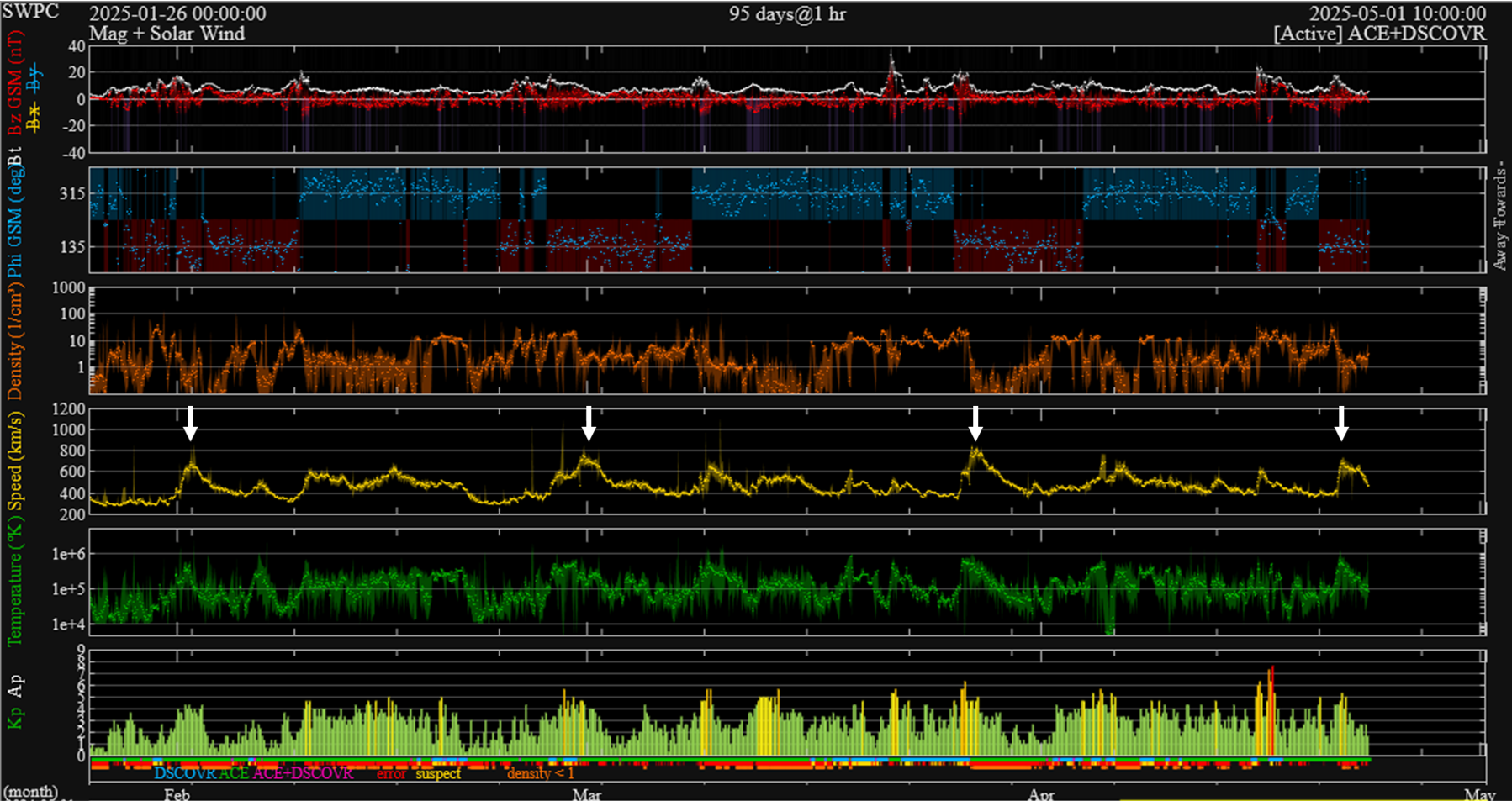Coronal holes are regions in the hot solar atmosphere ("corona") where the plasma density at that temperature is very low compared to its surroundings, and thus they look like dark shapes in the corona when viewed in soft x-rays or extreme ultraviolet (EUV). Linked to unipolar (i.e. "open") magnetic fields stretching into space, they are the source of the high-speed solar wind and can create geomagnetic disturbances. The wider the coronal hole, the longer any effects of the high speed stream will last.

The SDO/AIA 193 imagery above shows per solar rotation the outlook of the Sun in EUV. The dates are 29 January, 26 February, 25 March and 22 April 2025. Coronal holes in the northern and southern solar hemisphere can be seen respectively decaying and expanding, merging during the late March transit, with currently only the large coronal hole in the southern solar hemisphere remaining, albeit at mid-latitudes. With SPoCA, the Spatial Possibilistic Clustering Algorithm (Verbeeck et al. 2014), one can extract numerous parameters from specific solar features, including from coronal holes. The area of the coronal holes can be found on the SIDC's SolarMap website, and is expressed in Mm2 (square megameters). One square megameter is equal to 1 million square kilometers, and -for comparison- the total area of the Earth is about 510 million square kilometers. The compilation underneath shows PROBA-2/SWAP EUV images with contours compiled by SPoCA overlaid. The dates are 30 January, 26 February, 25 March and 22 April 2025.

The table underneath summarizes for those 4 days the total area of the coronal hole (combined for the January and February transit), the speed of the associated solar wind stream, the strength of the resulting geomagnetic disturbance (Kp; GFZ Potsdam), and the maximum daily electron fluence (GOES). The latter concerns electrons with energies greater than 2 MeV electron flux (see the STCE's SWx classification page). Satellite operators keep an eye on the number of these particles, because these energetic electrons can penetrate into spacecraft components and result in a build-up of charge within the material. When the accumulated charge becomes sufficiently high, an electrostatic discharge (ESD) or arching can occur. This discharge can cause anomalous behaviour in spacecraft systems and can result in temporary or permanent loss of functionality.

The table shows that the current coronal hole is somewhat smaller than during its previous transit, when it had an area about 750 times that of the Earth's surface (see the STCE newsitem). Coronal holes can be even larger, but it's all-in-all a rare happening (STCE newsitem). Solar wind speeds in excess of 700 and 800 km/s are typical for these large coronal holes, as shown in the annotated graph underneath (yellow curve; DSCOVR). Only minor to moderate geomagnetic storming (Kp = 5 to 6) has been recorded as a result from these high speed wind streams, most likely because of the positive polarity of the coronal holes, i.e. the magnetic field is directed away from the Sun (2nd panel: "phi angle" at 135 degrees). This doesn't favour a good connection with the Earth's magnetic field during the period of spring equinox (Russell, C.T. and McPherron, R.L. - 1973). Also, the greater than 2 MeV electron fluence reached only moderate levels.
The electron flux is expected to go up in the coming days under the influence of the ongoing high-speed, low-density solar wind stream, which arrived early on 21 April. The daily electron fluence may reach again moderate levels.






